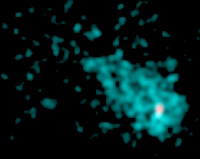December 11, 2000
CXC PR: 00-28
Three high school students, using data from NASA's Chandra X-ray Observatory and the National Science Foundation's Very Large Array (VLA), have found the first evidence of a neutron star in the nearby supernova remnant IC443, a system long studied by professional astronomers. This remarkable discovery has led the team to the national finals and a 1st place finish in the team competition at the Siemens-Westinghouse Science and Technology Competition held today in Washington, DC.
Charles Olbert (age 18), Christopher Clearfield (age 18), and Nikolas Williams (age 16), all of the North Carolina School for Science and Mathematics (NCSSM) in Durham, NC, found a point-like source of X rays embedded in the remains of the stellar explosion, or supernova. Based on both the X-ray and radio data, the students determined that the central object in IC443 is most likely a young and rapidly rotating neutron star -- an object known as a "pulsar."
"This is a really solid scientific finding," said Bryan Gaensler of the Massachusetts Institute of Technology, a noted pulsar expert who reviewed the paper for the team. "Everyone involved should be really proud of this accomplishment."
Taking advantage of Chandra's superior angular resolution, the North Carolina students found the source embedded in IC443, a region known to be emitting particularly high-energy X rays. In a highly unusual situation, the students got access to the Chandra data from their science teacher, Dr. Jonathan Keohane. Keohane applied for the observation time while still associated with NASA's Goddard Space Flight Center.
"The students really went through the whole analysis process themselves," said Keohane. "And, they even lived together all summer near the school to complete the research."
In order to confirm the evidence from Chandra, the students turned to the National Radio Observatory's Dale Frail who gave the student team VLA data on IC443. While the radio data did not reveal any periodicity, the VLA strengthened the team's case that a pulsar powers the supernova remnant by confirming the existence of the point-like source and discovering a cloud, or nebula, of high-energy electrons around the central object. Such nebulas are a common characteristic of pulsars.
"The experience of doing new and relevant science has been one of the most rewarding experiences I have ever had," said Olbert, a senior at NCSSM and lead author on the paper submitted to the Astrophysical Journal. "I never expected to publish a scientific paper while I was still in high school."
The remnant of the IC443 supernova is a well-studied object. Astronomers have searched this region (roughly 5,000 light years from Earth) for the neutron star created in the explosion that they thought should be there, judging from the size and dynamics of the supernova remnant.
The comet-shaped appearance of the cloud of high-energy particles indicates that the neutron star is moving through IC 443. Like the wake of a supersonic airplane, the swept-back shape of the nebula around the neutron star allowed the students to measure the speed it is traveling away from its origin. Using this result and the apparent distance that the neutron star has traveled from the center of the supernova remnant, the students calculated that the light from the initial explosion arrived at Earth about 30,000 years ago, thus addressing an outstanding question about IC 443.
Neutron stars, such as the one found by the NCSSM team, are the compact hot embers of very massive stars that have exhausted their fuel and expelled their own shells. The remaining cores, often no more than 10 miles in diameter, are very dense objects that sometimes spin and release beams of particles along their magnetic poles.
Created in 1998 by the non-profit Siemens Foundation, the Siemens-Westinghouse Science & Technology Competition promotes and advances science and mathematics education in America. The Competition is open to individuals and teams of high school students who develop independent research projects in the physical or biological sciences, or mathematics.
The North Carolina School of Science and Mathematics is a free statewide residential high school for students with a strong aptitude and interest in math and science. The NCSSM was founded in 1980 as part of the University of North Carolina system. About 550 high school juniors and seniors reside on the school's campus.
The National Radio Astronomy Observatory is a facility of the National Science Foundation, operated under cooperative agreement by Associated Universities, Inc. NASA's Marshall Space Flight Center in Huntsville, Alabama, manages the Chandra program. TRW, Inc., Redondo Beach, California, is the prime contractor for the spacecraft. The Smithsonian's Chandra X-ray Center controls science and flight operations from Cambridge, Massachusetts.
Images associated with this release are available on the World Wide Web at:
MEDIA CONTACTS
Dolores Beasley
NASA HQ
Phone: 202-358-1753
David Finley
National Radio Astronomy Observatory
Phone: 505-835-7302
Steve Roy
Marshall Space Flight Center, Huntsville, AL
Phone: 256-544-6535
Megan Watzke
Chandra X-ray Observatory Center, CfA, Cambridge, MA
Phone: 617-496-7998



